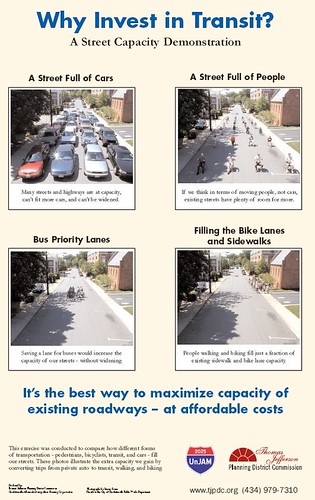This gets tiresome: an automobile driver insists that automobiles are efficient users of precious road space while transit vehicles are inefficient

From yesterday's Dr. Gridlock column in the Washington Post:
Dear Dr. Gridlock:
Streetcars are a bad idea.
I recall when they even used to run from Rockville to the District in the '50s. The tracks disrupted traffic and were hard for cars changing lanes or making turns to ride over. The streetcars were so wide they blocked two lanes. And went so slow with so many stops that they slowed those lanes to a stop-and-go crawl.
It was a happy day when they finally removed the tracks so cars could move more freely. Streetcars will mess up traffic even worse now that we have even more cars on the limited roads.
-- William Adams, Annandale
-----------------
I noticed in the latest Washington Area Bicyclist Association newsletter that they got funding to do a DC-based re-creation of the "Room to Breathe" poster that is comparable to the "unjam" poster from Charlottesville depicted above.
Three cars take up the space of one streetcar. More than 20 times the number of people are moved in the streetcar than in the three cars. So which type of vehicle, a transit vehicle like a streetcar or bus, or an automobile, messes up traffic on "the limited roads" that are overburdened with automobiles?

This photo shows a two-car streetcar consist in Portland. But you can see that the double streetcar unit in Portland is pretty small, about 66 feet long, which is 6 feet shorter than one DC subway car. If a car takes up about 20 feet on the street, allowing for a bit space in front and back to provide some space between other cars, a streetcar is just a wee bit longer than the equivalent of three car spaces on the road, being closer to four car spaces (maybe even 5 if drivers are smart enough to give the streetcar room). This two car streetcar consist can hold 140 passengers, while the four opr five cars it "displaces" from the road are likely to have 4-8 passengers.
As Jane Jacobs says in the book The Nature of Economies (paraphrased):
People are asking the wrong question. The question isn't why aren't there enough roads? The right question is asking why are there so many cars?
William Adams could be answering his own question, if it were the case that he asked the right question. I do wish that Dr. Gridlock would have pointed this out rather than leaving it unanswered.

The Room to Breathe poster from the New York City advocacy group, Transportation Alternatives, shows the same number of people and how much space they occupy on New York City streets depending on which mode they take: driving in a car, walking, bicycling, or using transit.
Labels: car culture and automobility, transportation planning, urban design/placemaking



0 Comments:
Post a Comment
<< Home